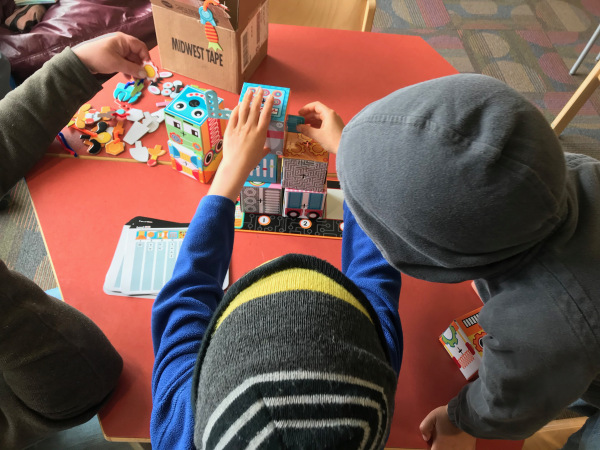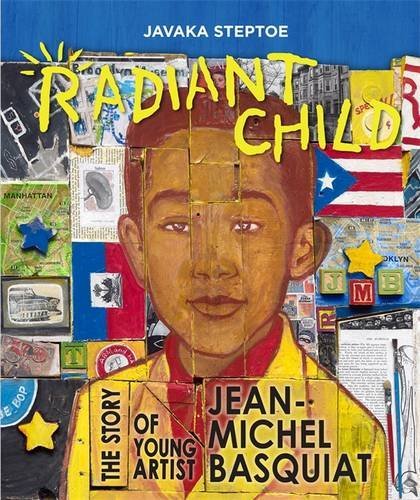This week, libraries, schools, and organizations across the country are highlighting the importance of media literacy. Regardless of the type of media, children and adults need to be savvy consumers. According to NAMLE, media literacy is defined as “the ability to access, analyze, evaluate, create, and act using all forms of communication.” Headlines about fake news and misinformation have driven home the vital need for critical thinking skills among all ages. While much of the media literacy attention focuses on older kids and teens, National Media Literacy Week is for preschoolers, too.
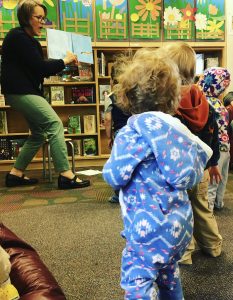
To some, the idea of teaching media literacy to preschoolers seems too sophisticated or academic. Yet, each week, preschoolers visit the Homer Public Library in Alaska for storytime and an informal lesson in media literacy. To passersby, the scene in the children’s library during storytime looks quite playful and very age-appropriate. They might look through the windows separating the children’s library from the rest of the building and see a librarian sharing some books, telling a story with some puppets, leading an activity with an iPad, or introducing an art or science project. My community is growing critical thinkers, and for many families, it all starts at storytime.
Teaching media literacy to preschoolers requires a shift in approach from the more common strategies implemented in programs for teens and older kids. Discussions about fake news, data accuracy, and advertising campaigns are important, but what resonates with young children? The good news is that the storytime culture found in many public libraries these days easily accommodates the key elements of media literacy.
Asking Questions, Active Thinking
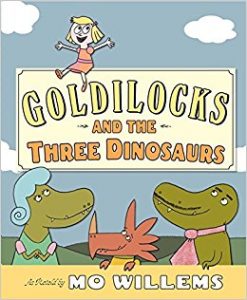
Storytime is not a performance, but a conversation. Fortunately, high quality children’s books are rich with content that make teaching aspects of media literacy in a storytime setting easy. For example, books by Mo Willems and Jon Klassen, among others, introduce the idea of unreliable narrators with young children. Their humor, uncluttered illustrations and clear story structure engage little ones and make room for open-ended discussions about the books. Preschoolers are observant and in storytime, they feel welcome to talk about what they see, think and feel. They are also encouraged to ask questions. Depending on the group and the book, I might ask:
- Who is the narrator?
- Who is the creator?
- What do you see?
- Is the story or information real or pretend? How do you know?
- Is it a joke?
- How does the story make you feel?
With open-ended questions like these, librarians encourage young children to extend the discussion about the relationship between the pictures and the words read aloud. Sometimes the illustrations and text align, and in other books they intentionally tell a different story. Look ahead 10 years, and the preschooler who has learned these critical thinking skills has become a teen who can discuss the relationship between the images and text in an ad, and what that ad’s message really is.
High Quality Media of all Kinds
Librarians are good at selecting high quality media of all kinds, which is a fundamental aspect of media literacy. Featuring stories and information in storytime that include a wide variety of topics and perspectives grow young children’s understanding of the world around them. Authentic tales from around the world, informational books about places, animals or holidays, and images or videos of real animals featured in illustrated stories all have value. A broad appreciation for the world beyond their own helps children evaluate media based on their own experience. Access to a variety of media helps children feel comfortable with a range of resources they will one day use in school and beyond to support or refute things that they read, hear, and see.
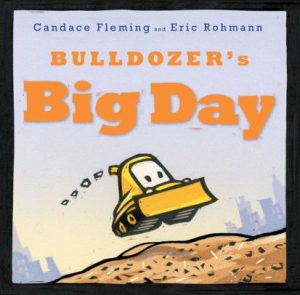
Storytime is an ideal time to introduce media that challenges stereotypes. Sharing vehicle books in storytime might alienate some listeners. But selecting truck books that feature characters of both genders contributing to the action, or a storyline that might appeal to children who love animals or reading or music, helps young listeners and their families connect with the story in different ways. A young girl who has not seen herself in books may see bulldozers, as in the case of Candace Flemings’ books, in a new light. To be successful, as librarians, educators, and caregivers, we must recognize our own biases especially when choosing and sharing media with children. Introducing books and other media that reflect children’s experiences and that are different from what they are already familiar with encourages them to analyze what they read, hear, and see as they get older.
Creating Content
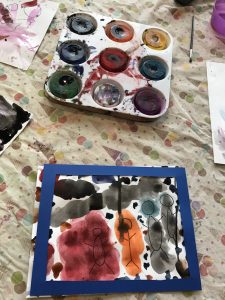
Storytime at the Homer Public Library includes time for children and their caregivers to create media with hands-on art and science projects. Regardless of the design, these projects offer little ones the opportunity to tell their own stories, test different materials, and extend their learning. Children learn about the different parts of media, and the tools used to make them, through this process. As they draw, cut, paint and mold, they talk story. The beauty—and the lesson—are in the process rather than the final product. Families make finger puppets to use while retelling a shared story, they paint or draw images with colors or materials similar to those used in a featured book, or they draw and write in an app on the library’s mounted iPad. As they grow, these preschoolers will have the chance to create comics, build apps, and much more.
Fundamentally, media literacy is really about literacy in the Digital Age. Our concept of what media is has broadened, but the value of literacy has not. Librarians, as media mentors, are tasked with supporting the media, literacy and information needs of families. We do this by providing access to experiences that help children and their families develop their critical thinking skills with a variety of media. At storytime, preschoolers are accessing, analyzing, evaluating, creating, and acting. They are also expanding their vocabulary, letter knowledge, narrative skills, background knowledge and collaborative skills. Media savvy adults begins in preschool. Come see for yourself. Bring a little one to storytime this week to celebrate Media Literacy Week!
More resources:
- ABC’s of Media Literacy: What Can Pre-Schoolers Learn? – by Faith Rogow
- How do I start teaching media literacy to my preschooler? – Common Sense Media
- Media Literacy in Early Childhood: A Critical Conversation – TEC Ericson Center
 Claudia Haines leads storytimes, hosts Maker programs, and gets great media into the hands of kids and teens as the Youth Services Librarian and Media Mentor at the Homer Public Library (Alaska). She is a co-author of the Association for Library Service to Children’s white paper, Media Mentorship in Libraries Serving Youth (2015). She trains other librarians as media mentors and serves on both local and national committees that support families and literacy. She blogs at www.nevershushed.com. @claudiahaines
Claudia Haines leads storytimes, hosts Maker programs, and gets great media into the hands of kids and teens as the Youth Services Librarian and Media Mentor at the Homer Public Library (Alaska). She is a co-author of the Association for Library Service to Children’s white paper, Media Mentorship in Libraries Serving Youth (2015). She trains other librarians as media mentors and serves on both local and national committees that support families and literacy. She blogs at www.nevershushed.com. @claudiahaines

